MOBILE VETERINARY



SWT/KWS MT. KENYA
UNIT JULY 2022
Cases in July 6 Rhino Cases 4 Elephant Cases
July Report by Dr. Dominic Mijele
July was a busy month for the Mt. Kenya Mobile Veterinary Unit, the team attended to 18 cases across the Laikipia ecosystem and Mt. Kenya region. 6 of these cases involved rhinos with one of the most prominent cases being ovum pick up on Fatu the last eligible northern white rhino oocytes donor held in captivity in Ol Pejata Conservancy. Other notable rhino cases included the capture and translocation of 3 healthy sub adult southern white rhinos, 2 females and 1 male, from Meru National Park to the Masai Mara. The Mt. Kenya Mobile Veterinary Unit also attended to 4 elephant cases and a host of other wildlife species. This included a leopard captured by KWS in community farms in the Kirimon area that was treated, ear notched and relocated to Loisaba conservancy; a mountain bongo that was limping due to a cracked hoof; and several cases involving common zebras that were successfully de snared.
Acknowledgement
We greatly appreciate the Sheldrick Wildlife Trust (SWT) for its continued support which enables the Mt Kenya Veterinary Unit to respond promptly to wildlife emergencies and offer lifesaving treatment.

Case Details
Date Species Area Found
Reason for Intervention Outcome
05 July 22 Elephant Buffalo Springs N.R. Rescue Found abandoned in the reserve. Task successful
06 July 22 Elephant Oldonyiro Laikipia Spear
07 July 22 Elephant Mpala Conservancy HWC
14 July 22 Rhino Ol Jogi, Laikipia
Roaming about with a spear lodged into the left side of its abdomen. Died
Multiple wounds to the left leg, eye and trunk. Likely caused by arrows during conflict Treated successfully
Natural causes Seen oozing blood from the inguinal area. Treated successfully

14 July 22 Zebra Nanyuki Arrow Had a penetrating pus filled wound right above the right eye Treated successfully
16 July 22 Zebra Balungi, Laikipia
Snared Seen with a snare around its neck Treated successfully
17 July 22 Rhino Solio Ranch Natural causes
17 July 22 Rhino Solio Ranch Natural causes
21 July 22 Rhino Meru N.P. Relocation
Exhibited lameness Treated successfully
Maintaining a dog sitting posture for a prolonged period which is unusual Died
Translocation from Meru National Park to the Masai Mara. Task successful
18
Introduction
25 July 22 Bongo
Kenya
25 July 22 Zebra Balungi, Laikipia
causes
Snared
26 July 22 Leopard Nanyuki, KWS Station HWC
27th & 28th July 2022 Rhino Ol Pejeta
29 July 22 Zebra Jua Kali, Laikipia
29 July 22 Zebra Jua Kali, Laikipia
29 July 22 Zebra Jua Kali, Laikipia
case
due to a cracked hoof.
with a snare around the neck.
Treated successfully
Treated successfully
in a trap set in community farms in Kirimon area. Task successful
pick up from Fatu, the last eligible
white rhino oocytes donor Task successful
Snared Seen with a snare around the neck. Task successful
Snared Seen with a snare around the neck.
Task successful
Snared Seen with a snare around the neck. Task successful
30 July 22 Elephant Borana Conservancy Natural causes Seen limping. Treated successfully
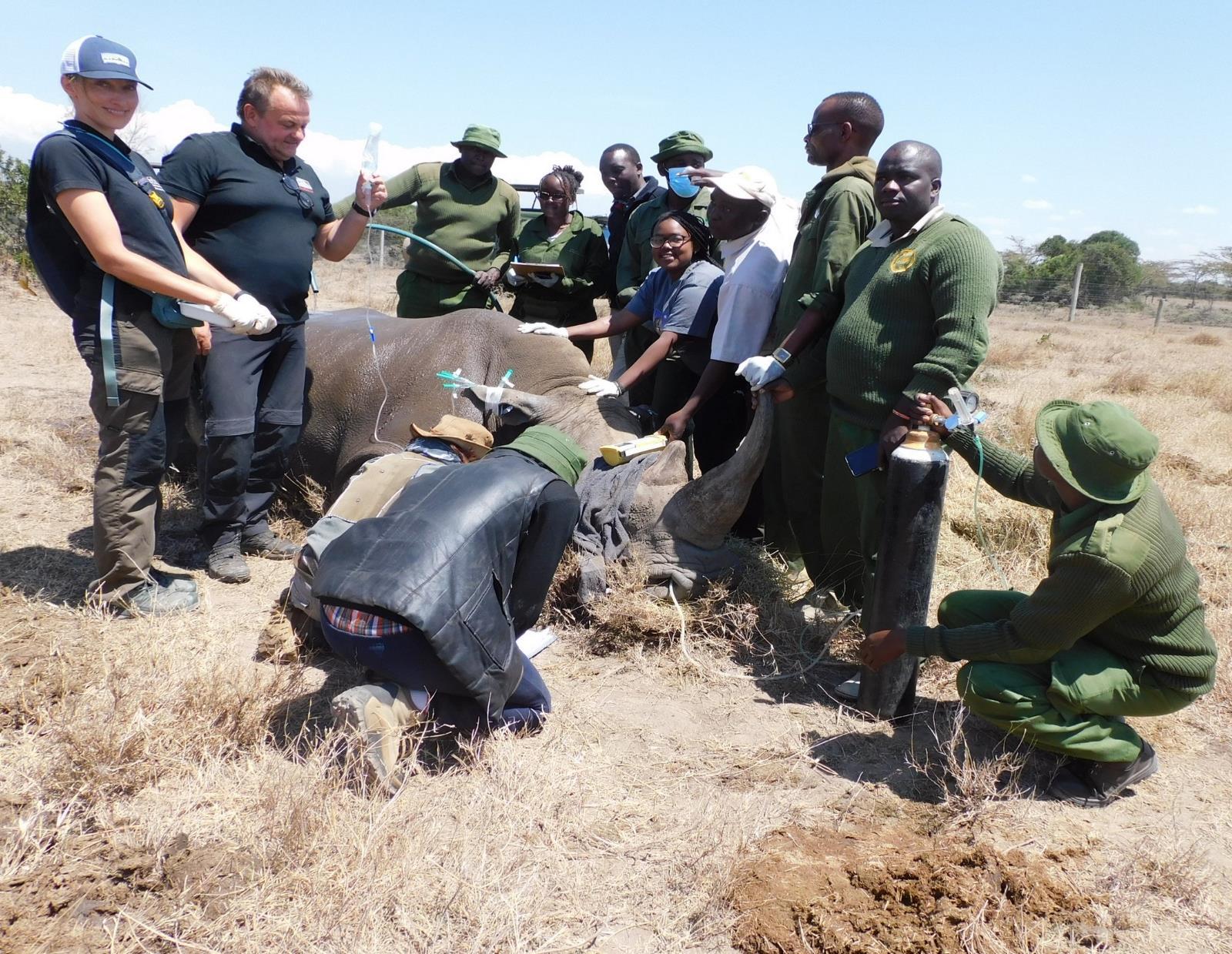
30 July 22 Rhino Solio Ranch
Post mortem
Black rhino carcass found by the security team. Task successful
Mt.
Conservancy Natural
limping
Seen
Caught
Conservancy Technical
Ovum
northern
Vet Unit Treatment


SWT/KWS Mt. Kenya Mobile
Locations July 2022
Elephant Rescue Buffalo Springs National Reserve
Immobilisation and rescue
The calf was immobilized with 1 mg Etorphine placed in a dart which was delivered by hand on the right rump. The elephant went down on its left side after 6 minutes. Anaesthesia was then reversed with 6 mgs Diprenorphine administered intravenously. The calf was loaded onto a vehicle and thereafter onto a Caravan which flew it to the SWT Nursery. The elephant was transported while alert under close monitoring of vital parameters.
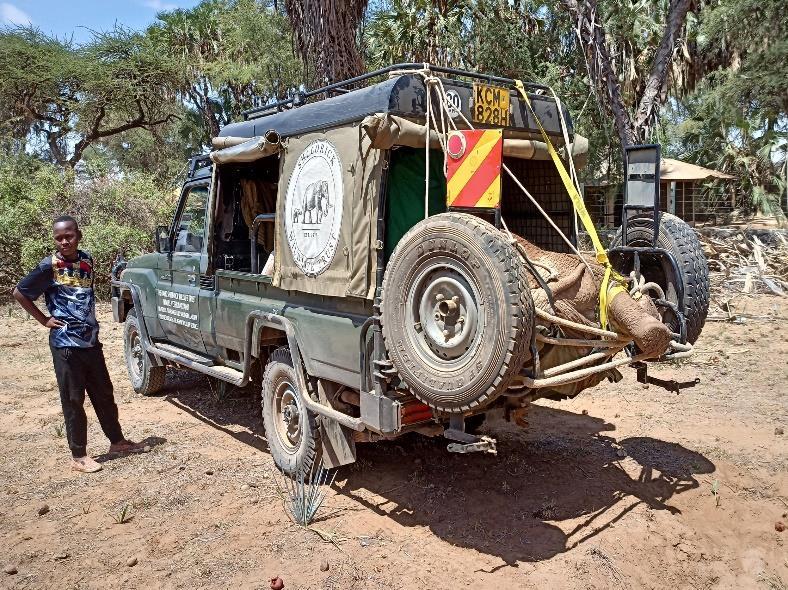
Prognosis
The calf was found in good body condition, and it arrived at the SWT elephant nursery in good health.



Case 1 05th July 2022
The 2.5 year old male elephant calf was found abandoned in Buffalo Springs National Reserve
Elephant Spear
Oldonyo Lengurai Farm
Rangers in the area reported seeing a lone elephant roaming about with a spear lodged into the left side of its abdomen. Upon arrival, the Mt Kenya Mobile Veterinary Unit found the elephant stuck in the middle of a dam.

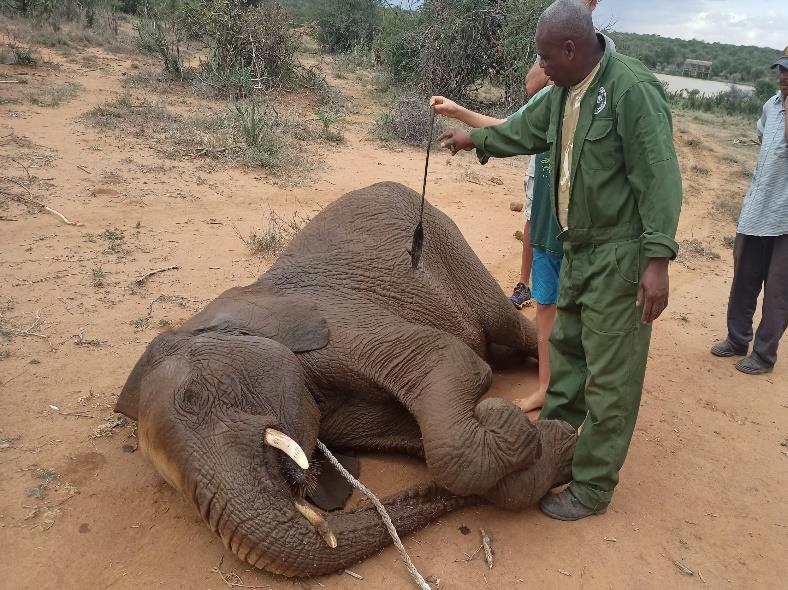


Prognosis
Sadly, the prognosis for this case was grave. The elephant drowned in the dam before any assistance or treatment could be given.
The carcass was retrieved from the dam and, a spear was recovered from a deep penetrating wound on the left side of the abdomen.
Case 2 06th July 2022
Elephant Human Wildlife Conflict Mpala Conservancy, Laikipia
The adult bull elephant was seen limping by the Mpala team



Immobilisation, examination and treatment
The elephant was darted on the left rump with 18 mgs Etorphine. When the drug took effect 6 minutes later, the elephant was lying on its left side. Anaesthesia monitoring was done continuously during treatment. Several injuries were observed, the elephant had a perforating injury on the medial aspect of the left hind limb; a superficial wound just above the left eye; a superficial injury next to the left eye; and multiple wounds on the dorsal aspect of the trunk These were likely caused by arrows during human wildlife conflict. 8,000 mgs Phenylbutazone and 15,000 mgs Amoxicillin were administered intramuscularly. The wounds were debrided with Hydrogen peroxide and flushed with Iodine then green clay paste was applied. The treated wounds were also sprayed with Oxytetracycline spray. Anaesthesia was reversed with 54 mgs Diprenorphine administered via the ear vein. The animal rose after 4 minutes.
Prognosis
The elephant has a good prognosis since it was treated early enough

Case 3 07th July 2022
White Rhino Natural Causes
Ol jogi, Laikipia
While on patrol, the Ol Jogi team spotted a male white rhino named Sawadi oozing blood from the inguinal area. It was suspected that Sawadi was involved in a territorial fight with another rhino.

Immobilisation, examination and treatment
Sawadi was approached on foot and darted with 4 mgs Etorphine. The dart landed on his right rump. The drug took effect after 6 minutes, and he went down on right lateral recumbency. Treatment and anaesthesia monitoring was done simultaneously. Oxygen supplementation was administered. 80 mgs Butorphanol was administered intravenously through the ear vein as supportive treatment to improve breathing. Sawadi had multiple traumatic deep penetrating wounds in the inguinal area, abdominal area and hind limbs. 15, 000 mgs Amoxicillin and 2,000 mgs Flunixine meglumine were administered intramuscularly. The multiple wounds were debrided with Hydrogen peroxide, flushed with Iodine, sealed with green clay paste and sprayed using Oxytetracycline spray. Anaesthesia was reversed with 100 mgs Naltrexone given intravenously and 24 mgs Diprenorphine administered intramuscularly. He rose after 3 minutes.
Prognosis
Sawadi has a good prognosis due to timely detection and management of his injuries
Case 4 14th July 2022
Zebra Arrow Nanyuki
Residents in the area spotted a male common zebra with an eye injury




Immobilisation, examination and treatment
The animal was immobilized with 4mgs Etorphine and 50mgs Azaperone. Darting was done from a vehicle with a Dan inject compressed CO2 dart gun. The dart landed on the left rump. The drugs took effect 7 minutes later with the animal on left lateral recumbency. The zebra was then placed on sternal recumbency and physically restrained. Treatment and anaesthesia monitoring was done simultaneously. The zebra had a penetrating pus filled wound above the right eye. This was likely caused by an arrow due to a poaching attempt. The animal was noted to be in a good body condition.
3,000mgs Amoxicillin and 4,000mgs Phenylbutazone were administered intramuscularly. The wound was debrided with Hydrogen peroxide, flushed with Iodine, sealed with green clay and sprayed with Tetracycline spray. Anaesthesia was then reversed with 12mgs Diprenorphine and the animal rose after 2 minutes.
Prognosis
The prognosis is good due to timely intervention.
Case 5 14th July 2022
Zebra Snared
Balungi Farm, Laikipia
Residents in Balungi Farm reported seeing a common zebra with a snare around its neck.

Immobilisation, examination and treatment
The zebra was darted on the right rump with 5mgs Etorphine and 50mgs Azaperone. The drug took effect after 7 minutes and the animal went down on right lateral recumbency. The snare around the zebra’s neck had cut deep into the neck muscles causing a traumatic wound. The animal was noted to have good body condition.
3,000mgs Amoxicillin and 4,000mgs Phenylbutazone were administered intramuscularly. The snare was cut off then the wound was debrided with Hydrogen peroxide, flushed with Iodine, sealed with green clay and sprayed with Oxytetracycline spray. Anaesthesia was reversed with 24mgs Diprenorphine administered via the jugular vein. The zebra rose after 2 minutes.
Prognosis
The zebra has a good prognosis due to timely detection and removal of the snare.



Case 6 16th July 2022
Rhino Natural Causes
Ranch, Laikipia
Immobilisation, examination and treatment
Chemical immobilization was done by darting with 4mgs Etorphine and 80mgs Azaperone. The dart landed on the right rump. The drug took effect after 6 minutes and the animal went down on its right side. Treatment and anaesthesia monitoring was done simultaneously. 80mgs Butorphanol was administered intravenously through the ear vein as supportive treatment to improve breathing. Multiple traumatic deep wounds were observed in the inguinal region and around the neck and chest region. 15, 000mgs Amoxicillin and 2,000mgs Flunixine meglumine were administered intramuscularly. The multiple wounds were debrided with Hydrogen peroxide, flushed with Iodine, sealed with green clay and sprayed with Oxytetracycline spray. Anaesthesia reversal was done with 100mgs Naltrexone intravenously and 24mgs Diprenorphine administered intramuscularly. The animal rose after 3 minutes.
Prognosis
The prognosis was good due to timely detection and management of the rhino’s injuries




Case 7 17th July 2022
Solio
The Solio team reported that a male white rhino was exhibiting lameness.
Rhino Natural Causes

Solio Ranch, Laikipia
The Solio team reported that a male white rhino had been maintaining a dog sitting posture for a prolonged period which is an unusual behaviour in these animals.

Immobilisation and examination
The rhino was approached on foot and darted with 4mgs Etorphine and 80mgs Azaperone on the right rump. The drug took effect after 6 minutes, and the animal went down on right lateral recumbency. Treatment and anaesthesia monitoring was done simultaneously. It was observed that the rhino had a rectal prolapse and a spinal cord injury believed to have been suffered during a territorial fight. The spinal cord injury resulted in paralysis of the hind legs hence the sitting posture.


Prognosis
The prognosis was grave since the injury had rendered the rhino lame. The rhno was put to rest.
Case 8 17th July 2022
Rhino Relocation
Meru National Park to Maasai Mara
Three healthy white rhinos, 2 females and one male, were translocated from Meru National Park to the Masai Mara.

Immobilisation, collection of samples and translocation
The rhinos were darted from a helicopter with Etorphine and Azaperone. Once the drugs had taken effect, the animal were immediately blindfolded, and their ears plugged to reduce stimulation. Vital parameters were monitored including respiratory rates and depth of respiration, blood circulation/tissue perfusion (pulse rate), mucous membrane colour, moisture and rectal body temperature. Oxygen supplementation was also done through the nostrils at a rate of 10 15 L/min. 25 mg Butorphanol was also immediately administered intravenously to stabilize cardio respiratory parameters. The average respiratory rate was 10 breaths per minute (measured by feeling for expired air through the nares). Additionally, Azaperone was administered intramuscularly to cater for transportation stress. Ear notching had already been done therefore the tissue growth on existing notches was removed and oxytetracycline spray applied to deter flies and prevent infection. Samples were collected for future analysis including blood (EDTA and serum), tissue and ticks. Anaesthesia was reversed with 100 mgs of Naltrexone I.V and 12 mgs Diprenorphine I.M All animals were translocated while alert under close monitoring of vital parameters. The rhinos were successfully released at the release site in the Maasai Mara
Case 9 21st July 2022
Bongo Natural Causes
Mt. Kenya Wildlife Conservancy
Immobilisation, examination and treatment
The bongo was approached on foot and darted with 4mgs Etorphine and 40mgs Azaperone. The dart landed on the left shoulder muscles. The drug took effect after 5 minutes and the animal went down on its right side. It was then placed in sternal recumbency and physically restrained. Treatment and anaesthesia monitoring was done simultaneously. Oxygen supplementation was administered for optimal breathing. The bongo had a cracked hoof on the right forelimb and had overgrown hooves. 4,000mgs Phenylbutazone and 3,000mgs Amoxicillin were injected intramuscularly. The cracked hoof and overgrown hooves were trimmed then the cracked hoof was flushed with Iodine and sprayed with Oxytetracycline. Anaesthesia was reversed with 12mgs Diprenorphine administered via the jugular vein. The animal rose 3 minutes later.

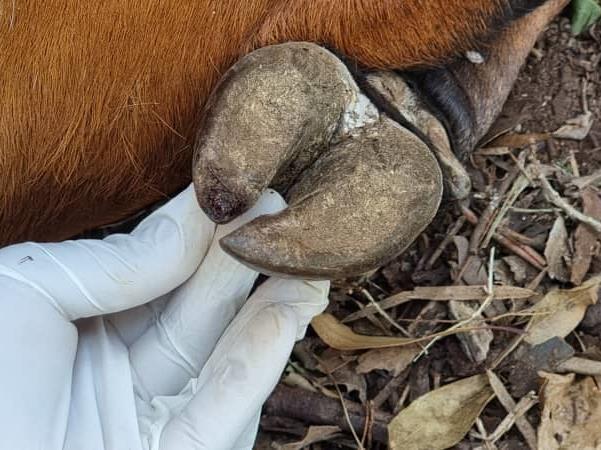
Prognosis
The prognosis is good due to timely detection and intervention.
Case 10 25th July 2022
A female pregnant mountain bongo was reported to be limping due to a cracked hoof
Zebra Snared Balungi Farm

Immobilisation, examination and treatment
The foal was immobilized with 3mgs Etorphine and 40mgs Azaperone. Darting was done from vehicle using a Dan inject compressed CO2 dart gun. The dart landed on the right rump with the animal going down on its right side after 7 minutes
The snare around the neck had made a superficial cut on the skin and caused an abrasion wound. The animal was noted to be in good body condition. The snare was removed then the wound was debrided with Hydrogen peroxide, flushed with Iodine and sprayed with Oxytetracycline spray. Reversal of anaesthesia was done with 12mgs Diprenorphine administered via the jugular vein. The animal rose after 2 minutes.

Prognosis
The foal has a good prognosis since the injury caused by the snare was minimal due to timely detection and intervention.
Case 11 25th July 2022
The farm’s residents reported seeing a common zebra foal with a snare around the neck
Leopard Human Wildlife Conflict
Nanyuki KWS Station
A female sub adult leopard was caught in a trap set in community farms in Kirimon area, Samburu. The leopard had sustained minor injuries that required treatment before being released.

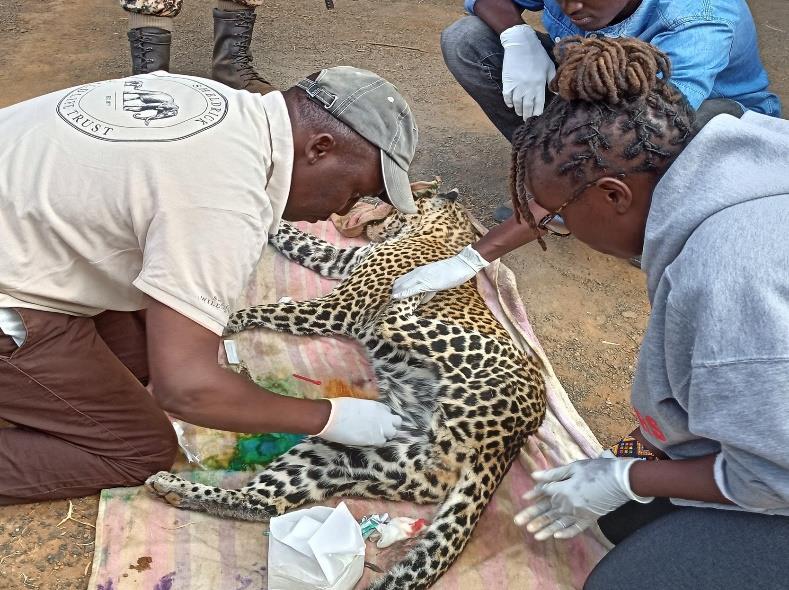
Immobilisation, examination and treatment
Chemical immobilization was done with 70 mgs Ketamine combined with 0.7 mgs Medetomidine. The leopard was approached on foot and darted on the left rump. The drug took effect after 15 minutes, and the animal went down on sternal recumbency. The animal was good in body condition. It had a minor injury on the tail. The wound on the tail was debrided with Hydrogen peroxide, flushed with Iodine and sprayed with Oxytetracycline spray. Blood samples were collected from the femoral vein for EDTA and serum. Whiskers and tissue sample were also collected and stored in ethanol for further analysis. Anaesthesia reversal was done with 15 mgs Atipamazole administered intramuscularly. The animal rose after 5 minutes.
Prognosis
The prognosis for this leopard is good. It was translocated and released in Loisaba Conservancy, Laikipia.
Case 12 26th July 2022
Rhino Technical Case
Ol Pejeta Conservancy
Report on the Northern White Rhino Ovum Pick Up that took place on 27th and 28th July 2022 at Ol Pejeta Wildlife Conservancy.



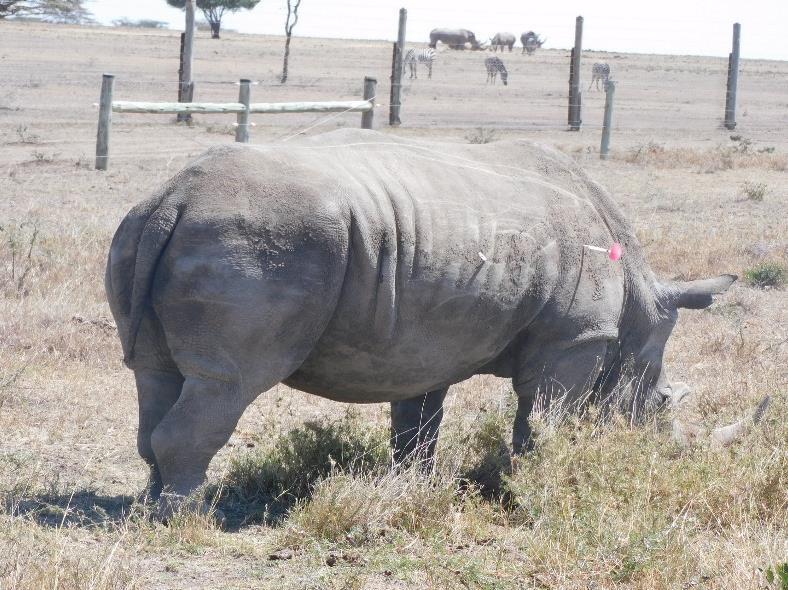
The Northern White Rhino population has declined with the last remaining individuals, Najin and Fatu, being kept in captivity at the Ol Pejeta Conservancy. The two females cannot have a viable pregnancy due to health and age related problems. Najin, the older female, has a large ovarian tumor and has very weak hind legs, while Fatu developed untreatable endometriosis, making her uterus unable for embryo implantation.
An in depth ethical risk assessment led to the team retiring the older of the two remaining females, 32 year old Najin, as a donor of egg cells leaving Fatu as the only eligible oocytes donor. This activity presented a group of scientists with an opportunity to collect oocytes from Fatu and carry out a reproductive health check.
Case 13 27th & 28th July 2022
Zebra Snared
Jua Kali, Laikipia
Residents in Jua Kali area reported seeing 3 common zebra, 1 stallion and 2 females, each of them having a snare around the neck.

Immobilisation, examination and treatment
The zebras were darted from a vehicle with 5mgs Etorphine and 50mgs Azaperone. Each animals had a loose wire snare around the neck.
Luckily, none of the zebras had suffered any injury, and all the animals were in good body condition. The snares were removed then anaesthesia was reversed since there was no need for further treatment.
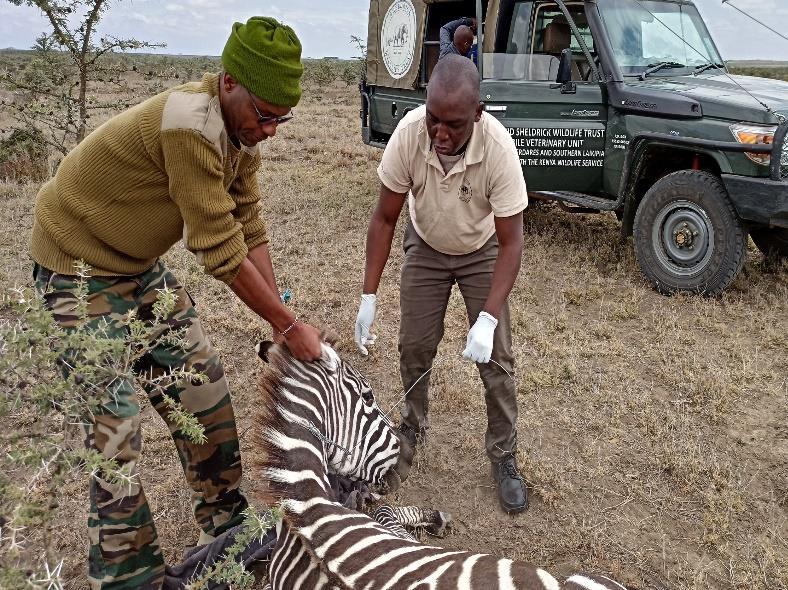

Prognosis
The prognosis for the 3 zebras is good since the snare were detected and removed before they could inflict injury

Case 14, 15 and 16 29th July 2022
Elephant Natural Causes Borana Conservancy


The Mount Kenya Mobile Veterinary Unit were informed of an elephant bull that was limping.

Immobilisation, examination and treatment
The elephant was darted from a vehicle with 17 mgs Etorphine on the right rump. The animal went down on its left side after 6 minutes. It was observed that elephant was in good body condition. However, it had multiple abrasion wounds on the posterior aspect of the right fore limb.

The elephant was treated with 8,000 mgs Phenylbutazone and 15,000mgs Amoxicillin intramuscularly. The wound was debrided with Hydrogen peroxide, flushed with Iodine then covered with Oxytetracycline spray. Anaesthesia reversal was done with 48 mgs Diprenorphine administered via the ear vein. The elephant rose 5 minutes later.
Prognosis
The elephant has a good prognosis due to timely detection of the injury and prompt intervention.
Case 17 30th July 2022
Rhino Post mortem Solio Ranch
Solio ranch security team found the black rhino carcass

General examination
The carcass was found lying in dorsal recumbency. The entire carcass had been eaten by lions and it was in no state for a detailed post mortem examination.
Cause of death
The rhino was suspected to have been involved in a territorial fight, and later it was predated upon and devoured by lions.
Case 18 30th July 2022

























































